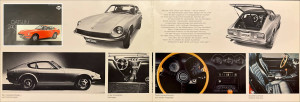Many things disappear somewhere in the shadows and are rarely retrieved. They are forgotten. Nobody cares, and in general, some secrets just don't seem to want to be told that often.
Today's story is about how Nissan did a photo shoot at the very end of development, shortly before the presentation of the 240Z or Fairlady Z, before it was even clear what the emblems of the car would look like or what specs the individual export markets would have.
It's actually pretty crazy when you think about it these days.
Nissan puts a car in the studio sometime in 1969, takes photos of it, and still uses the resulting photos years later. But then, with a few adjustments here and there. And this was long before the invention of Photoshop or other computer programmes.
But not only that. Even the bumpers and other things were reworked. Technically quite complex, without today's modern methods.
However, I would like to start by collecting all the photos from this shoot.
As I said, the point is that these photos clearly show the following things:
- All emblems are missing from the body. The hubcaps do not show the typical "D" either.
- The car has no antenna, just a rubber plug at this position.
- There is no clock and no radio in the interior (hence no antenna). But: DATSUN is already written on the horn. In a clearly different font, as all other emblems were later given.
- The car has "typical US" overriders on the bumpers. But let's not forget that this was also an option in Japan to protect against parking damage!
- The car has side marker lights for the US market at the front and rear.
- The car is red.
- In the engine compartment, we see a blue air filter box.
- It is a left-hand drive vehicle.


 Florian Steinl
Florian Steinl 























